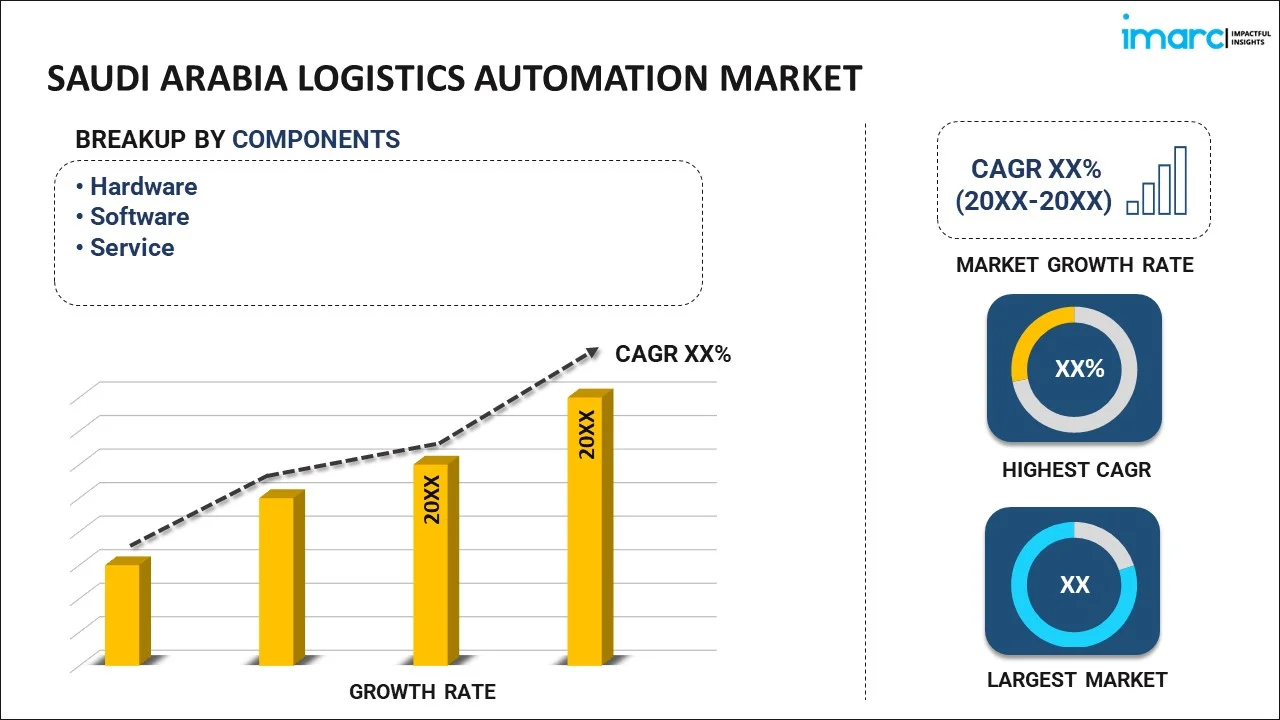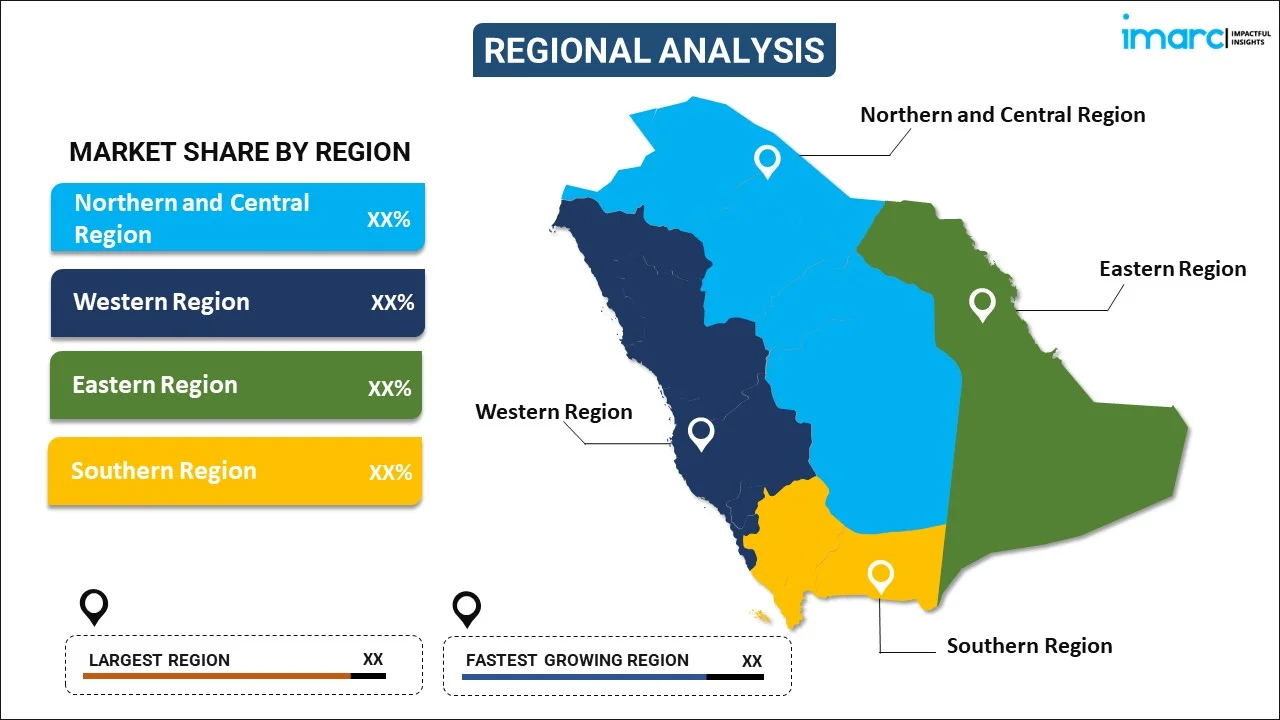
Saudi Arabia Logistics Automation Market Report by Component (Hardware, Software, Service), Function (Warehouse and Storage Management, Transportation Management), Enterprise Size (Small and Medium-sized Enterprises, Large Enterprises), Industry Vertical (Manufacturing, Healthcare and Pharmaceuticals, Fast-Moving Consumer Goods (FMCG), Retail and E-Commerce, 3PL, Aerospace and Defense, Oil, Gas and Energy, Chemicals, and Others), and Region 2024-2032
Market Overview:
Saudi Arabia Logistics Automation Market size reached US$ 556.25 Million in 2023. Looking forward, IMARC Group expects the market to reach US$ 1075.42 Million by 2032, exhibiting a growth rate (CAGR) of 7.10% during 2024-2032.The growing focus of organizations on reducing the workforce required for labor-intensive tasks, such as sorting, weighing, barcoding, counting, picking, and packing, is primarily driving the market growth across the country.
|
Report Attribute
|
Key Statistics
|
|---|---|
|
Base Year
|
2023 |
|
Forecast Years
|
2024-2032
|
|
Historical Years
|
2018-2023
|
| Market Size in 2023 | US$ 556.25 Million |
| Market Forecast in 2032 | US$ 1075.42 Million |
| Market Growth Rate (2024-2032) | 7.10% |
Logistics automation involves employing computer software or automated machinery to enhance the efficiency of logistics operations. It plays a pivotal role in minimizing errors associated with manual data entry and elevates customer services through features such as automated pick-up, real-time freight tracking, comprehensive insurance, and automatic notifications. Additionally, logistics automation contributes to a reduction in the workforce required for various processing tasks, including sorting, weighing, barcoding, counting, picking, and packing. Its scalability, speed, and accuracy make it increasingly sought after nationwide.
Saudi Arabia Logistics Automation Market Trends:
The logistics automation market in Saudi Arabia is undergoing a transformative surge, propelled by the country's commitment to technological advancements and its strategic emphasis on enhancing efficiency across industries. The implementation of features, such as automated pick-up, real-time freight tracking, insurance management, and automatic notifications not only minimizes manual data entry errors but also enhances the overall experience for end-users. One of the key advantages of logistics automation in Saudi Arabia is its role in reducing the workforce required for labor-intensive tasks such as sorting, weighing, barcoding, counting, picking, and packing. This not only enhances efficiency but also aligns with the broader trend of optimizing labor resources and deploying them in more strategic and value-added roles within the supply chain. Additionally, the scalability, speed, and accuracy inherent in logistics automation make it a compelling solution for businesses across the country. The demand for these advanced solutions is likely to expand further as businesses seek to stay competitive, meet evolving customer expectations, and capitalize on the efficiency gains offered by automation in the logistics sector. Besides this, collaborations between technology providers, logistics companies, and government initiatives are driving innovation and accelerating the adoption of logistics automation, positioning Saudi Arabia at the forefront of logistics efficiency in the region, which is anticipated to fuel the market growth over the forecasted period.
Saudi Arabia Logistics Automation Market Segmentation:
IMARC Group provides an analysis of the key trends in each segment of the market, along with forecasts at the country level for 2024-2032. Our report has categorized the market based on component, function, enterprise size, and industry vertical.
Component Insights:

- Hardware
- Mobile Robots (AGV, AMR)
- Automated Storage and Retrieval Systems (AS/RS)
- Automated Sorting Systems
- De-palletizing/Palletizing Systems
- Conveyor Systems
- Automatic Identification and Data Collection (AIDC)
- Order Picking
- Software
- Warehouse Management Systems (WMS)
- Warehouse Execution Systems (WES)
- Services
- Value Added Services
- Maintenance
The report has provided a detailed breakup and analysis of the market based on the component. This includes hardware (mobile robots (AGV, AMR), automated storage and retrieval systems (AS/RS), automated sorting systems, de-palletizing/palletizing systems, conveyor systems, automatic identification and data collection (AIDC), and order picking), software (warehouse management systems (WMS) and warehouse execution systems (WES)), and service (value added services and maintenance).
Function Insights:
- Warehouse and Storage Management
- Transportation Management
A detailed breakup and analysis of the market based on the function have also been provided in the report. This includes warehouse and storage management and transportation management.
Enterprise Size Insights:
- Small and Medium-sized Enterprises
- Large Enterprises
The report has provided a detailed breakup and analysis of the market based on the enterprise size. This includes small and medium-sized enterprises and large enterprises.
Industry Vertical Insights:
- Manufacturing
- Healthcare and Pharmaceuticals
- Fast-Moving Consumer Goods (FMCG)
- Retail and E-Commerce
- 3PL
- Aerospace and Defense
- Oil, Gas and Energy
- Chemicals
- Others
A detailed breakup and analysis of the market based on the industry vertical have also been provided in the report. This includes manufacturing, healthcare and pharmaceuticals, fast-moving consumer goods (FMCG), retail and E-commerce, 3PL, aerospace and defense, oil, gas and energy, chemicals, and others.
Regional Insights:

- Northern and Central Region
- Western Region
- Eastern Region
- Southern Region
The report has also provided a comprehensive analysis of all the major regional markets, which include Northern and Central Region, Western Region, Eastern Region, and Southern Region.
Competitive Landscape:
The market research report has also provided a comprehensive analysis of the competitive landscape in the market. Competitive analysis such as market structure, key player positioning, top winning strategies, competitive dashboard, and company evaluation quadrant has been covered in the report. Also, detailed profiles of all major companies have been provided.
Saudi Arabia Logistics Automation Market Report Coverage:
| Report Features | Details |
|---|---|
| Base Year of the Analysis | 2023 |
| Historical Period | 2018-2023 |
| Forecast Period | 2024-2032 |
| Units | US$ Million |
| Scope of the Report | Exploration of Historical and Forecast Trends, Industry Catalysts and Challenges, Segment-Wise Historical and Predictive Market Assessment:
|
| Components Covered |
|
| Functions Covered | Warehouse and Storage Management, Transportation Management |
| Enterprise Sizes Covered | Small and Medium-sized Enterprises, Large Enterprises |
| Industry Verticals Covered | Manufacturing, Healthcare and Pharmaceuticals, Fast-Moving Consumer Goods (FMCG), Retail and E-Commerce, 3PL, Aerospace and Defense, Oil, Gas and Energy, Chemicals, Others |
| Regions Covered | Northern and Central Region, Western Region, Eastern Region, Southern Region |
| Customization Scope | 10% Free Customization |
| Report Price and Purchase Option | Single User License: US$ 3699 Five User License: US$ 4699 Corporate License: US$ 5699 |
| Post-Sale Analyst Support | 10-12 Weeks |
| Delivery Format | PDF and Excel through Email (We can also provide the editable version of the report in PPT/Word format on special request) |
Key Questions Answered in This Report:
- How has the Saudi Arabia logistics automation market performed so far and how will it perform in the coming years?
- What has been the impact of COVID-19 on the Saudi Arabia logistics automation market?
- What is the breakup of the Saudi Arabia logistics automation market on the basis of component?
- What is the breakup of the Saudi Arabia logistics automation market on the basis of function?
- What is the breakup of the Saudi Arabia logistics automation market on the basis of enterprise size?
- What is the breakup of the Saudi Arabia logistics automation market on the basis of industry vertical?
- What are the various stages in the value chain of the Saudi Arabia logistics automation market?
- What are the key driving factors and challenges in the Saudi Arabia logistics automation?
- What is the structure of the Saudi Arabia logistics automation market and who are the key players?
- What is the degree of competition in the Saudi Arabia logistics automation market?
Key Benefits for Stakeholders:
- IMARC’s industry report offers a comprehensive quantitative analysis of various market segments, historical and current market trends, market forecasts, and dynamics of the Saudi Arabia logistics automation market from 2018-2032.
- The research report provides the latest information on the market drivers, challenges, and opportunities in the Saudi Arabia logistics automation market.
- Porter's five forces analysis assist stakeholders in assessing the impact of new entrants, competitive rivalry, supplier power, buyer power, and the threat of substitution. It helps stakeholders to analyze the level of competition within the Saudi Arabia logistics automation industry and its attractiveness.
- Competitive landscape allows stakeholders to understand their competitive environment and provides an insight into the current positions of key players in the market.
Need more help?
- Speak to our experienced analysts for insights on the current market scenarios.
- Include additional segments and countries to customize the report as per your requirement.
- Gain an unparalleled competitive advantage in your domain by understanding how to utilize the report and positively impacting your operations and revenue.
- For further assistance, please connect with our analysts.
 Inquire Before Buying
Inquire Before Buying
 Speak to an Analyst
Speak to an Analyst
 Request Brochure
Request Brochure
 Request Customization
Request Customization




.webp)




.webp)












